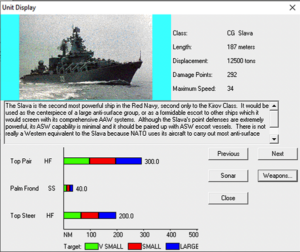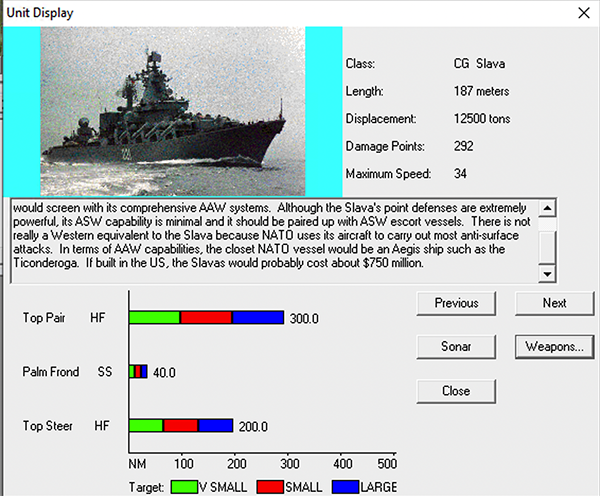 In 1989, one of my favorite computer games was published: Harpoon.
In 1989, one of my favorite computer games was published: Harpoon.
In the game, players take control of very detailed naval and aviation assets in future Cold War (e.g., US vs. USSR) scenarios. Real ships are used and a great deal of care went into modeling the capabilities, including sensors, detection, missiles, acquiring targets, etc. The same detail was given to air combat, with the display showing range circles indicating active radar, passive radar, missile ranges, time to BINGO, etc. The scenario editor offered many options and quite literally trillions in military hardware to play with.
The game came of age when the techno-military media craze of the 80s was peaking. Authors like Tom Clancy and Larry Bond published thrillers (such as The Hunt for Red October) in which the protagonists were often the aircraft carriers and nuclear submarines themselves as much as the somewhat obligatory military men who drove them. Harpoon (named after a US anti-ship missile) allowed players to live in this world at an incredible depth.
As the years passed, a number of scenario packs were released, including the GIUK Gap (Greenland-Iceland-UK – a very strategic waterway for both NATO and the USSR’s Northern fleet), one allowing play on the entire Atlantic (with many “US resupplying Europe vs. USSR subs” scenarios), one focused on the Mediterranean (allowing all sorts of Middle East crisis scenarios), and one for the Indian Ocean, which included a massive Desert Storm scenario I must have played a dozen times.
Harpoon II eventually followed but was a dud, and the franchise eventually fell apart. It was a bit too wargame niche, and I suspect the people who funded realized there was a lot more money in other kinds of games. Also, without massive Cold War fleets to oppose each other, the scenarios were much less interesting.
When I heard that the Moskva had sunk, I read about it but it didn’t register on me that I had fought, sunk, and been sunk by that ship perhaps a hundred times. That’s where Proxmox comes in.
Some days after hearing of the initial sinking, I saw a mention in the press that the Moskva was originally named the Slava in the USSR era.
The Slava! That ship was infamous in Harpoon because it was one of the big missle-sluggers of the Soviet fleet. The Soviet Navy was always very missile-oriented, probably building on their land-based rocket expertise. While all major navies have the same kinds of weapons, the Soviets always emphasized ships that could throw big volleys of missiles. The USSR had only a minimal carrier force, while it operated many cruisers, battlecruisers, and even small patrol boats that were little more than floating launching pads for massive missile batteries.
The name “Slava” to me conjures up images of my carrier fleets racing across the North Atlantic, confidently sweeping submarines ahead of them, only to suddenly encounter a massive wave of SS-N-12 Sandbox missiles sailing in from over the horizon at Mach 3. The launching fleet was usually a collection of big Soviet iron and the Slava was always in the mix. Soviet doctrine took “attack effectively first” (a naval axiom) to the extreme of “attack with everything first” and most of their ships were designed to deliver a single massive blow. This made the attack often difficult to defend against just because of its volume, and made going after the attacker rather tedious. You couldn’t just leave them out there to harass ships, but they weren’t worth expending munitions since their major threats were expended.
I haven’t played Harpoon in years, but decided to fire up a copy of the 1995 Commander’s Edition on a Proxmox VM.
Question: Will Windows 11 run in Proxmox, with tall that fancy TPM requirement and such?
Answer: Yes. Proxmox will be happy to spoof a TPM for you. In fact, you can select where to store it and what version you want during VM creation:

After that, it was easy to install Windows, enable Remote Desktop, and fire up Harpoon. Let’s see what it has to say about the Slava (I’ve repeated the first image twice because I can’t make the text area bigger in the game and it’s cut off in the first picture):



Looking at the game’s commentary is fascinating in 2022:
- The authors could not have imagined a world where this ship would be sunk by an independent Ukraine’s indigenously-produced missile.
- The mention of ASW (anti-submarine warfare) capabilities would be very relevant in a 1980s “running the GIUK gap” scenario…not so much in the Black Sea in 2022.
- A cost of $750 million in 1989 would be $1.7 billion in 2022, which is about half of what the British paid for a QE-class aircraft carrier.
- The “comprehensive AAW systems” invites a snicker but they may well have been comprehensive in 1989 compared to threats of that era. Perhaps they were not adequately updated to modern threats.
Thanks for the trip back in time, Proxmox!























Leave a Reply